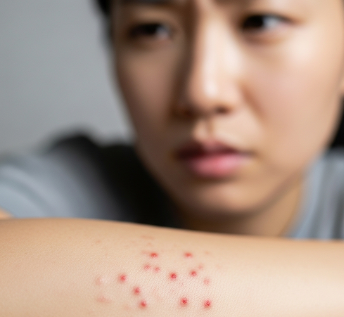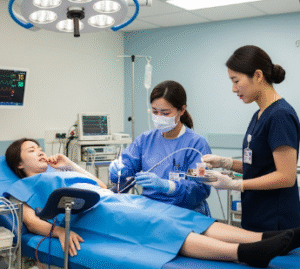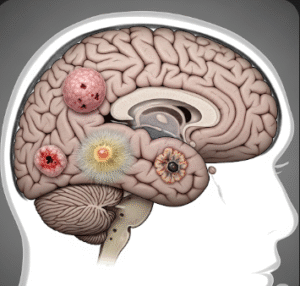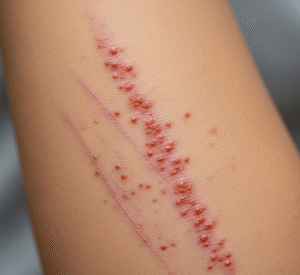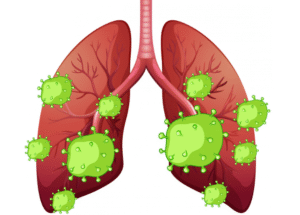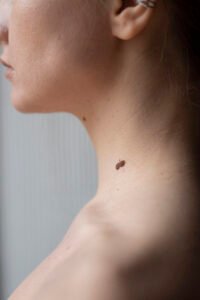Overview
Petechiae are small, pinpoint red, purple, or brown spots that appear on the skin or mucous membranes. They result from tiny blood vessels (capillaries) breaking under the skin, causing minor bleeding. While petechiae themselves are usually harmless, they may also be a sign of underlying medical conditions that require attention. These spots do not blanch (turn white) when pressed, which helps distinguish them from other types of skin rashes.
➤ Petechiae can appear in clusters or spread over large areas, depending on the cause.
➤ They often appear on the arms, legs, stomach, or mucous membranes such as the mouth or eyelids.
➤ Timely evaluation is essential because in some cases, petechiae may signal serious disorders such as infections, blood clotting problems, or autoimmune conditions.
In Korea, dermatologists and hematology specialists offer comprehensive evaluation and treatment options, combining advanced blood tests, imaging, and minimally invasive interventions.
Key Facts
➤ Petechiae are tiny (1–2 mm) spots that result from capillary bleeding under the skin.
➤ They do not blanch when pressed, distinguishing them from rashes caused by inflammation or allergic reactions.
➤ Petechiae may be localized or widespread, depending on the underlying cause.
➤ Causes range from minor trauma to serious systemic conditions, including infections and blood disorders.
➤ Korean medical centers provide specialized diagnostic facilities, ensuring prompt identification and treatment.
What is Petechiae?
Petechiae are defined as small, pinpoint, non-blanching spots caused by bleeding under the skin or mucous membranes. They are usually less than 2 millimeters in diameter and may be red, purple, or brown.
➤ Medical perspective: Petechiae are a type of purpura, with purpura being larger spots (>2 mm) and ecchymoses being even larger (>1 cm).
➤ Mechanism: The rupture of tiny blood vessels leads to the leakage of blood into surrounding tissues.
➤ Appearance: They are flat to the touch, and their color changes over time as the blood is reabsorbed.
Petechiae themselves are not painful or itchy, but the presence of accompanying symptoms may indicate an underlying condition that needs urgent attention.
What Symptoms Are Related To
Petechiae can occur alone or alongside other symptoms that hint at their underlying cause:
➤ Fever and chills – may indicate infectious causes.
➤ Easy bruising or bleeding – suggests a clotting or platelet disorder.
➤ Fatigue or weakness – seen in anemia or bone marrow conditions.
➤ Swelling of lymph nodes – may be associated with infections or hematological malignancies.
➤ Mucous membrane bleeding – such as nosebleeds or gum bleeding.
➤ Abdominal pain or jaundice – in cases related to liver disorders.
Identifying these associated symptoms helps clinicians determine the urgency and type of diagnostic tests required.
What Causes / Possible Causes
Petechiae can arise from various conditions, ranging from benign to severe:
➤ Trauma or physical strain:
➤ Intense coughing, vomiting, or prolonged straining can rupture capillaries.
➤ Minor injuries or pressure may trigger localized petechiae.
➤ Infections:
➤ Viral infections – such as measles, mononucleosis, or dengue.
➤ Bacterial infections – like meningococcemia or septicemia, which require urgent medical attention.
➤ Blood disorders:
➤ Thrombocytopenia – low platelet count due to immune conditions or medications.
➤ Hemophilia or other clotting factor deficiencies.
➤ Leukemia or bone marrow disorders affecting blood cell production.
➤ Medications and toxins:
➤ Certain antibiotics, chemotherapy drugs, or anticoagulants can increase susceptibility.
➤ Autoimmune or systemic conditions:
➤ Vasculitis – inflammation of blood vessels.
➤ Lupus or other autoimmune diseases affecting vascular integrity.
➤ Nutritional deficiencies:
➤ Lack of vitamin C (scurvy) can weaken capillaries and lead to petechiae.
The cause of petechiae must be determined promptly, especially if it occurs suddenly, spreads rapidly, or is accompanied by systemic symptoms.
When Should I See My Doctor
Petechiae can indicate serious medical conditions, so timely evaluation is critical:
➤ Sudden appearance of widespread petechiae without clear trauma.
➤ Accompanied by fever, chills, or fatigue, which may signal infection.
➤ Bleeding from gums, nose, or other sites, suggesting clotting problems.
➤ Persistent or recurring spots, which may indicate a chronic blood disorder.
➤ Associated with abdominal pain, jaundice, or swollen lymph nodes.
In Korea, rapid access to dermatologists and hematologists ensures early diagnosis, monitoring, and treatment, which can prevent life-threatening complications.
Care and Treatment
The management of petechiae depends on the underlying cause, rather than treating the spots themselves:
➤ Observation:
➤ Minor, trauma-related petechiae often resolve spontaneously within days.
➤ Treat underlying infections:
➤ Antibiotics for bacterial causes.
➤ Antiviral therapy or supportive care for viral infections.
➤ Manage blood disorders:
➤ Platelet transfusions or clotting factor replacement for deficiencies.
➤ Immunosuppressive therapy for autoimmune conditions affecting platelets.
➤ Address nutritional deficiencies:
➤ Supplement vitamin C, vitamin K, or other essential nutrients as required.
➤ Lifestyle adjustments:
➤ Avoid activities that may exacerbate bleeding.
➤ Regular monitoring of blood counts and coagulation profiles.
➤ Follow-up: Continuous monitoring ensures that underlying conditions are effectively managed and recurrence is minimized.
Treatment Options in Korea
Korean medical facilities provide state-of-the-art evaluation and treatment for petechiae and related conditions:
➤ Hematology centers – advanced testing for platelet counts, clotting factors, and bone marrow evaluation.
➤ Infectious disease units – rapid diagnosis and treatment of bacterial or viral causes.
➤ Dermatology clinics – monitor skin manifestations and provide supportive care.
➤ Specialized nutritional and systemic therapy programs – correcting deficiencies and managing autoimmune or chronic conditions.
➤ Integrated treatment plans – combining medications, lifestyle counseling, and follow-up monitoring.
➤ Emergency care availability – in cases of severe infection or bleeding disorders.
Patients in Korea benefit from highly skilled specialists, cutting-edge diagnostics, and comprehensive care programs, ensuring optimal outcomes for petechiae and its underlying causes.

